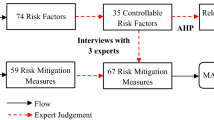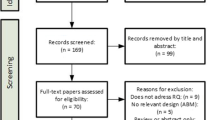Abstract
The operational efficiency of an urban emergency response plan (UERP) is proportional to the magnitude of a rigorous assessment process. The core objective of the assessment process is to identify possible deficiencies, in particular, micro-deficiencies existing within the emergency plans. Most of the existing approaches rely on multi-criteria and emergency state for assessments. However, identification of micro-deficiencies requires developing a comprehensive microscopic model of the entire emergency system and simulating an emergency plan under various scenarios. Here, an assessment framework is proposed based on agent-based modeling and geosimulation and considering the urban features for general and microscopic assessment of urban emergency response plans. To enrich our claim, this framework is applied to assess the futuristic emergency infrastructure plan of upgrading overhead water tanks (OWT) to be used for recharging fire emergency vehicles in case of fire incidents to improve fire suppression time by the Fire Department of Allahabad City, an urban city of India.
















Similar content being viewed by others
References
Amouroux E, Chu TQ, Boucher A, Drogoul A (2007) GAMA: an environment for implementing and running spatially explicit multi-agent simulations. In Pacific Rim International Conference on Multi-Agents, pp. 359–371. Springer Berlin Heidelberg
Bernardes SMF, Rebelo F, Vilar E, Noriega P, Borges T (2015) Methodological approaches for use virtual reality to develop emergency evacuation simulations for training, in emergency situations. Procedia Manuf 3:6313–6320
Bukowski RW, Hurley MJ (2003) Fire hazard analysis techniques. NFPA, Fire Protection Handbook, Section 3: 121–134
Chen CC, Nagl SB, Clack CD (2007) Specifying, detecting and analysing emergent behaviours in multi-level agent-based simulations. In Proceedings of the 2007 Summer Computer Simulation Conference, pp. 969–976. Society for Computer Simulation International
Chen A, Chen N, Li J (2012) During-incident process assessment in emergency management: concept and strategy. Saf Sci 50(1):90–102
Fagel MJ (2011) ed. Principles of emergency management: hazard specific issues and mitigation strategies. CRC Press
Girard C, David P, Piatyszek E, Flaus J-M (2016a) Emergency response plan: model-based assessment with multi-state degradation. Saf Sci 85:230–240
Girard C, David P, Piatyszek E, Flaus J-M (2016b) Emergency response plan: model-based assessment with multi-state degradation. Saf Sci 85:230–240
Grimwood P, Barnett C (2005) Fire-fighting flow rate, www.firetactics.com
Guo D, Ren B, Wang C (2008) Integrated agent-based modeling with GIS for large scale emergency simulation. In: International symposium on intelligence computation and applications. Springer, Berlin, Heidelberg, pp 618–625
Heard D, Dent G, Schifeling T, Banks D (2015) Agent-based models and microsimulation. Annu Rev Stat Appl 2:259–272
Heppenstall AJ, Crooks AT, See LM, Batty M, eds. Agent-based models of geographical systems. Springer Science & Business Media, 2011
Ju Y, Wang A, Liu X (2012) Evaluating emergency response capacity by fuzzy AHP and 2-tuple fuzzy linguistic approach. Expert Syst Appl 39(8):6972–6981
Liu Y, Fan Z-P, Zhang Y (2014) Risk decision analysis in emergency response: a method based on cumulative prospect theory. Comput Oper Res 42:75–82
Mendonca D, Beroggi GEG, Van Gent D, Wallace WA (2006) Designing gaming simulations for the assessment of group decision support systems in emergency response. Saf Sci 44(6):523–535
Mysore V, Narzisi G, Mishra B (2006) Emergency response planning for a potential sarin gas attack in Manhattan using agent-based models. In: Proceedings of the first international workshop on agent technology for disaster management, Hakodate, Japan, pp 108–115
Navidi WC (2006) Statistics for engineers and scientists. Vol. 2. McGraw-Hill, New York
Olson DK, Scheller A, Wey A (2014) Using gaming simulation to evaluate bioterrorism and emergency readiness training. J Public Health Manag Pract 20:S52–S60
Olson DK, Hoeppner MM, Scaletta K, Peck M, Newkirk R Games, simulations, and learning in emergency preparedness: a review of the literature. Am J Disaster Med 7(2, 2011):145–154
Paganini M, Borrelli F, Cattani J, Ragazzoni L, Djalali A, Carenzo L, Corte FD, Frederick M Jr, Ingrassia PL (2016) Assessment of disaster preparedness among emergency departments in Italian hospitals: a cautious warning for disaster risk reduction and management capacity. Scand J Trauma Resusc Emerg Med 24(1):101
Pilone E, Mussini P, Demichela M, Camuncoli G (2016) Municipal emergency plans in Italy: requirements and drawbacks. Saf Sci 85:163–170
Ren P, Xu Z, Jing G (2016) Assessments of the effectiveness of an earthquake emergency plan implementation with hesitant analytic hierarchy process. Int J Inf Technol Decis Mak 15(06):1367–1389
Särdqvist S (1996) An engineering approach to fire-fighting tactics , Report 1014, Department of Fire Safety Engineering, Lund University, Sweden
Schoenharl T, Madey G, Szabó G, Barabási AL (2006) WIPER: a multi-agent system for emergency response. In Proceedings of the 3rd international ISCRAM conference, vol. 1.
Taillandier P, Vo DA, Amouroux E, Drogoul A (2010) GAMA: a simulation platform that integrates geographical information data, agent-based modeling and multi-scale control. In International Conference on Principles and Practice of Multi-Agent Systems, pp. 242–258. Springer Berlin Heidelberg
Training Manual—How to Conduct Emergency Management Exercise (EMEx)National Disaster Management Authority, Government of India (2016)
Wagner N, Agrawal V (2014) An agent-based simulation system for concert venue crowd evacuation modeling in the presence of a fire disaster. Expert Syst Appl 41(6):2807–2815
Walker WE, Giddings J, Armstrong S (2011) Training and learning for crisis management using a virtual simulation/gaming environment. Cogn Tech Work 13(3):163–173
Wooldridge M, Jennings NR (1995) Intelligent agents: theory and practice. Knowl Eng Rev 10(02):115–152
Bo Y, Wu YG, Wang C (2009) A multi-agent and GIS based simulation for emergency evacuation in park and public square. In IEEE, international conference computational intelligence and security, 2009. CIS’09. on, vol. 1, pp. 211–216
Zhang G, Ma J, Jie L (2009) Emergency management evaluation by a fuzzy multi-criteria group decision support system. Stoch Env Res Risk A 23(4):517–527
Zhong M, Shi C, Tairan F, He L, Shi J (2010) Study in performance analysis of China Urban Emergency Response System based on Petri net. Saf Sci 48(6):755–762
Zhou J, Reniers G, Khakzad N (2016) Application of event sequence diagram to evaluate emergency response actions during fire-induced domino effects. Reliab Eng Syst Saf 150:202–209
Author information
Authors and Affiliations
Corresponding author
Electronic supplementary material
ESM 1
(DOCX 26 kb)
Rights and permissions
About this article
Cite this article
Bandyopadhyay, M., Singh, V. Agent-based geosimulation for assessment of urban emergency response plans. Arab J Geosci 11, 165 (2018). https://doi.org/10.1007/s12517-018-3523-5
Received:
Accepted:
Published:
DOI: https://doi.org/10.1007/s12517-018-3523-5




